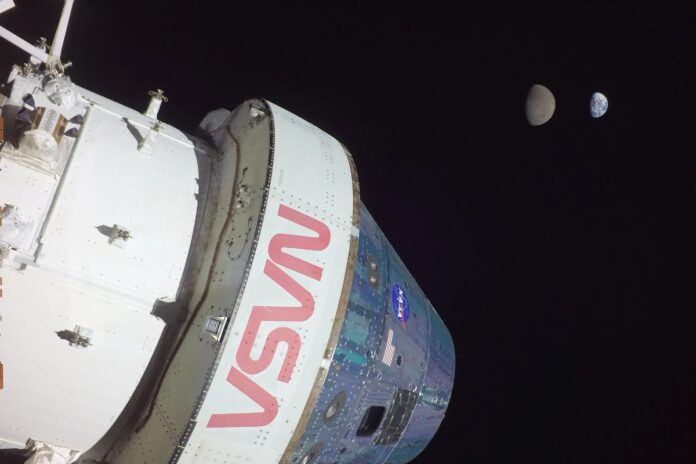Carl Sagan, whose Cosmos series introduced so many to the phrase “pale blue dot,” would have liked the photograph that accompanies this posting. Sagan coined the phrase when he pointed to a picture taken by Voyager 1 from the vicinity of Saturn, with the Earth a small blue dot just above one of the gas giant’s rings. This picture is taken much closer, about 429,700 kilometres (268, 563 miles) from our planet. The Orion capsule is in the foreground.
As beautiful as the picture is, it comes with a US $4.1 billion cost. The Artemis program to return humans to the Moon, currently scheduled for either 2025 or 2026, has been a colossal boondoggle, a make-work project for cost-plus NASA contractors who never deliver on time or on budget.
So far, NASA engineers are pleased with the performance of the Orion capsule and its companion ESA-built service module. So, $4.1 billion of over-engineered technology does buy something. The capsule is expected to return to Earth on December 11th, landing in the Pacific Ocean.
Forgetting the ridiculous cost behind us getting this image of a distant Earth, it is the smallness of our planet against the backdrop of space that makes it so compelling. This is Lifeboat Earth floating through the blackness of space. This is currently the only place in the Universe where we know there is life. And the technologically-driven civilization that sent the space capsule beyond the Moon to take the picture is currently putting everything on that lifeboat at risk.
It is the dream of NASA and other national space programs to land on other worlds. Artemis is targeting the Moon. The plan is to create a permanent human presence there. Beyond it, NASA has set its sights on Mars where we intend to land in the future.
The 19th-century American fixation with “manifest destiny” seems to have translated in the 21st century from an Earthly objective to one that reaches the Moon, Mars and beyond. One of the biggest promoters of the new version of this doctrine is Elon Musk, the founder of SpaceX. He is building a spaceship to transport human colonizers to Mars beginning in the next decade or two. He wants to make humanity a multiplanet species. His fear is one day a space rock will crash into Earth and wipe us out. Meanwhile, we are doing a pretty good job of wiping life out right here in our own backyard.
We may have already altered Mars and a chance for us to find a second planet where life could have arisen. Mars may have already been invaded by Earth’s microbiology. How? Since the 1970s, we have sent landers, and more recently rovers to Mars. And although precautions are taken to eliminate unwanted Earthly hitchhikers, these missions could be contaminated with Earth microbiology. And when humans finally land on Mars, we will bring far more invaders that include the microflora and fauna contained within us.
Even the Moon may already be contaminated by life from Earth. In 2019, Israel’s Beresheet lunar mission attempted a landing on the Moon’s surface. It crashed but inside the probe were Tardigrades, eight-legged microscopic creatures native to Earth. On board, they were contained in a state of suspended animation. If they survived when exposed to water they could become animated. Recent discoveries tell us that water is present in the lunar regolith. So even the lifeless Moon may have its first living Earth invaders, and that’s before we establish a permanent colony and begin shedding and eliminating all of our attendant microflora and fauna in the lunar environment.
That pale blue marble beyond the Moon that hauntingly appears in the NASA image should make us aware of the fragility of our remarkable home planet. How inconsequential it seems against a backdrop of space. It truly is Lifeboat Earth and we need to shore up the leaks we are causing and row it in the right direction to ensure it will still be a place for life on Earth for a billion or more years to come.
In the next week, the 15th Conference of the Parties (COP15) for the United Nations Convention on Biological Diversity is meeting in Montreal, Quebec. The focus will be on restoring biodiversity and fighting pollution and climate change. Someone should hang the NASA picture over the entrance to the conference to remind participants just how fragile the life we take for granted is here on our home planet.









